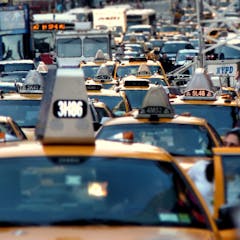
Articles on Cities
Displaying 661 - 680 of 1515 articles

In the future, Europe will suffer from more heat waves as well as extreme rainfall, presenting new challenges for planners and health care services. Building resilient cities can help.

One potential benefit of WestConnex, which remains untouched, is that it could relieve Sydney’s city centre from cars and make it more pedestrian-friendly.

For a public space to be seen as safe, welcoming and accessible, a diverse range of people need to actively use it. That’s why any space-changing project needs to engage broadly with the community.

New York soon may charge a fee to drive into central Manhattan as a way of reducing traffic and raising funds for public transit. An urban scholar says this step is overdue in the United States.

A comparison of Australian cities reveals cyclists and walkers are still very much a minority of commuters, despite the economic, health and environmental costs. Action on three fronts is needed.

A new report suggests one in four jobs could be at risk in cities outside the south.

Big data provides a rich picture of the physical city, but it won’t tell us much about the social city – that’s where agent-based modelling comes in.

3D urban modelling is a transformative technology for designing cities. But incorporating new technologies into planning practice has its challenges.

Developers will now be responsible for dealing with noise issues from nearby music venues – but it will take real community activism to prevent closures.

Looking back through all Melbourne’s strategic plans from 1929 onwards, it becomes clear that the 20th-century legacy of car-centric planning and its focus on parking is still deeply entrenched.

There are three key cultural reasons why a share-bike business model that could be successful in Singapore is much less likely to be so in Australia.

There is a risk that affordable housing policy may be colonised by for-profit interests if Australia imports the wrong rental housing ideas from overseas.

Understanding population density takes more than just arithmetic – that’s where mapping can help reveal which countries and cities are really getting cramped.

Australian cities generally minimise negative attributes such as crime, segregation and violence, but developing positive attributes such as inclusivity appears more challenging.

Welcome to the era of TechPlomacy where a new world order is emerging around cities and their economies, rather than nations and their borders.

The real challenge is finding appropriate ways to invest in public transport that will not only take pressure off the system but also support improved travel on all modes, including cars.

If we’re going to intervene to stop the dumping of share bikes, we need to understand the bad behaviour in the first place, then design effective measures to change how bike users behave.

Our health depends on the quality of air indoors, where most of us spend 90% of our time. The easiest solution is to open a window, but what if that’s not an option?

An expert in criminology explains why you shouldn’t believe everything you see on TV – organised crime is still a very British problem.

Across Japan, towns and villages are vanishing as the population ages and young people move to the cities. How the country manages this holds lessons for other developed nations facing a similar fate.
